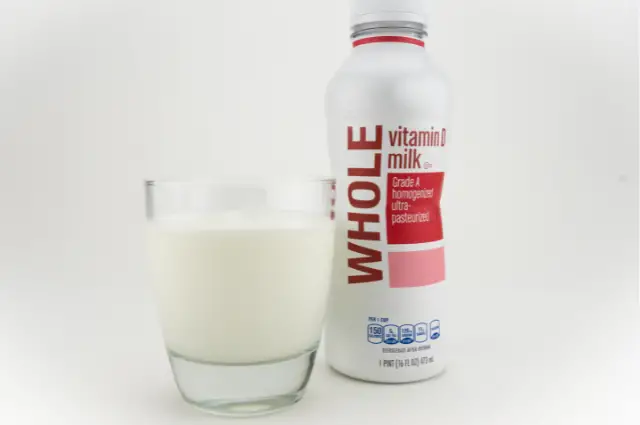This post may contain affiliate links, which means that I may earn a commission if you make a purchase using these links at no extra cost to you.
Whole milk simply means milk in its most purest form. Besides the fat present in milk, the main component of this milk is water. In whole milk, you will also find things like vitamins, minerals, sugars such as lactose, and proteins such as casein, and whey proteins.
Because whole milk contains calcium and vitamin D, it helps babies develop strong and healthy bones.
Baby formula, on the other hand, is a manufactured food formulated for feeding babies within the age of twelve months. It is usually prepared for cup or bottle feeding, from either powder or liquid. If you are a mother who cannot breastfeed or for a reason or two decided not to, baby formula is a hygienic alternative.
Is whole milk more filling than formula?
Ideally, your baby should take 16-24oz of whole milk daily, but they may have to take about 32 oz in one day, in formula. If your baby takes more solids, though, the milk consumption won’t be high.
It is not that whole milk is particularly more filling than formula, it all depends on your baby, and their needs per time.
Milk is more of a drink than a meal though, so it makes sense that it may happen not to be as filling as formula.
Is Whole Milk Less Filling Than Formula?
The difference between whole milk and formula is significant, but not very much so. While the formula has around 3.6% fat, most whole milks contain about 4% fat.
Whole milk has fewer calories and less fat compared to infant formula, so if you find your baby wants more of whole milk every time, even when they have taken so much, it is not unreasonable. Whole milk is possibly less filling.
Milk and formula are not equal. While milk is only a part of a baby’s diet alongside proteins, fruits, grains and veggies, formula is formulated to provide all the calories/ proteins/ vitamins required. Whole milk is far from this.
Paediatricians normally recommend 24oz, but this value doesn’t have to be absolute. Except, of course, it is affecting your baby’s solids. There are times your baby will take 32 oz and still eat 3 solid meals and snacks, that’s not abnormal.
The key thing is to always feed them something good and not junk food. Babies have a regulated appetite, and will make you know when they have had enough.
Formula vs Whole Milk
It is a recommendation of The American Academy of Pediatrics (AAP) that babies should be breastfed until twelve months of age. But in reality, not all mothers are physically capable of breastfeeding their babies, or decide to.
In cases of this type, parents subscribe to healthy alternatives, such as whole milk or infant formula. Whole milk and formula differ significantly in terms of nutritional composition, and this forms the basis of the recommendation from The American Academy of Pediatrics against giving a child below twelve months of age milk. The reason is that these foods/drinks have high allergy risks.
Infant Formula
Infant formulas are developed to mimic the nutrition of breast milk. The formula gives your baby almost everything breast milk will. The absence of live antibodies in infant formula is the main thing that differentiates it from breast milk.
Formulas come with every other thing breast milk has, including vitamins, and minerals such as calcium, phosphorus, and the likes. They also contain fats, proteins, and score all nutritional eligibility postulated by the U.S. Food and Drug Administration’s Infant Formula Act.
Whole Milk
Ultimately, whole milk should not be served until your baby turns one year old. As a parent, one of the nursing temptations that is worth resisting is introducing whole milk to your little one when the time is not yet right. You don’t want to do this. As it may kindle certain allergic reactions in your baby at a very early stage.
Your baby’s digestive system is most fragile before their first year birthday. This is why you need to wait till it develops enough to take whole milk. Whole milk is an amazing source of nutrients for children, but only delivers productive results when introduced at the right time.
But here’s another thing to keep in mind — if your baby is overweight, at a risk of the same, or there’s a family history of weight conditions, the American Academy of Pediatrics advises 2% milk instead of whole milk. This helps to tamp down on the risks.
Fresh Milk vs Formula for Toddlers
Breast milk is the best of all milks. But when it comes to picking between fresh milk and formula for your toddler, well, the answer may amaze you.
It is a popular advice that after one year, you can very well go ahead to give your baby fresh milk instead of formula, but if your child hasn’t started on certain regular foods, you may not want to dive into it.
In your choice of any food for your little one, nutritional value should be a yardstick, as much as your financial reality.
No long talk, in terms of nutrition, formula takes every medal. And when it comes to affordability, infant formula wins that too.
Benefits of Continuing Formula After One Year
If your baby is on a stage 3 formula and you want them to keep an increased vitamin D level, then it makes sense that the formula is continued after one year. According to research conducted by HiPP infants who continued on a stage 3 formula after their first birthday, had improved vitamin D levels, relative to their counterparts who switched to whole milk.
Conclusion
What your baby eats and doesn’t eat is possibly the most important thing in child nursing. You want to be sure if they are taking the right foods/drinks in at the right time. We have written extensively on whole milk and things you should know about it, in this article. We hope the information helps you.

